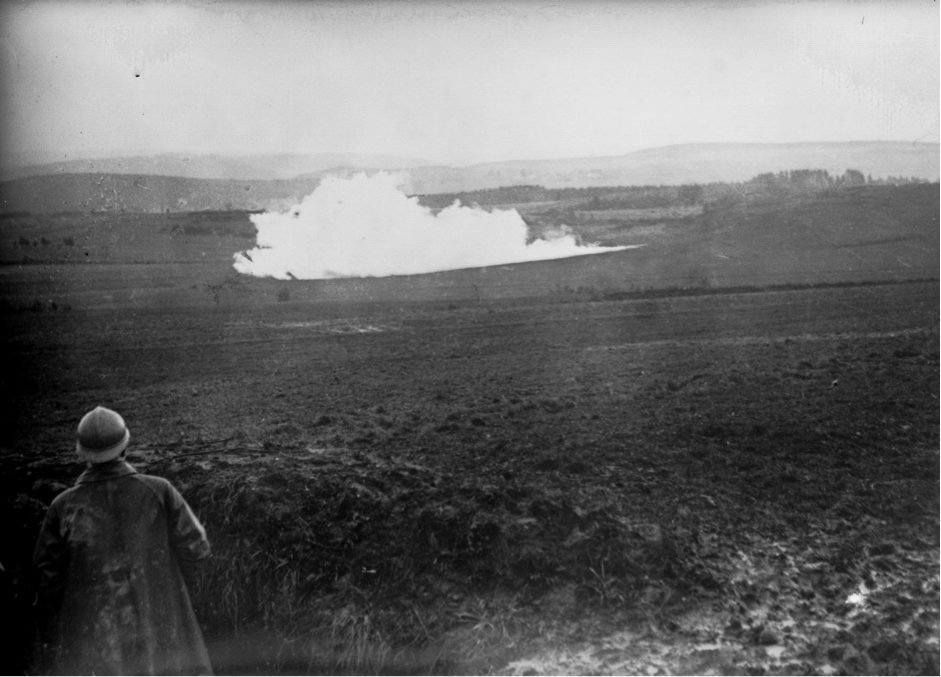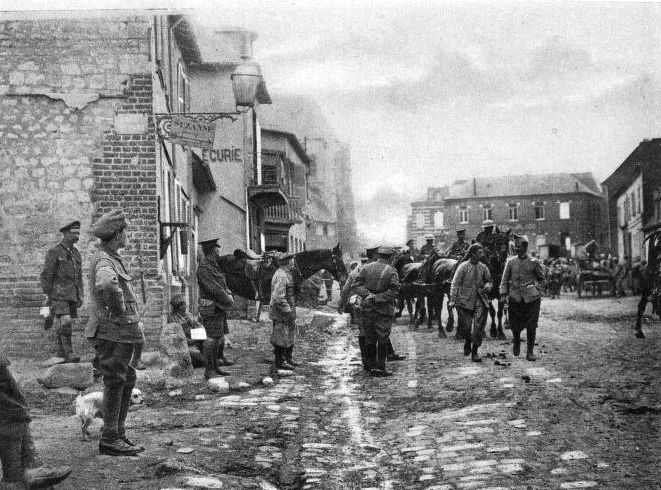Conflicts prior to the Somme 1916

1916 mine explosion in front of French positions (source Bibliotheque Nationale de France)
At the end of 1915, the Allies planned a series of attacks against Germany. Britain and France were to launch a major offensive across the River Somme. Prior to this attack, British troops were caught up in various conflicts in the early months of 1916. The following three men from Radcliffe on Trent lost their lives at this time:
April 30th 1916, Mine explosion, Vimy Ridge. Death of Corporal 2770 Alvin Newbury, 1st/6th (City of London) Battalion (Rifles), 4th London Brigade, 47th (1st/2nd London) Division. Had he lived, it is likely that he would have received a commission. The battalion was on a tour of duty at Vimy Ridge, which began in March 1916. On April 30th, it suffered over 80 casualties from a German mine explosion under the British Line (the crater was later renamed Mildren Crater. It was held successfully by the London battalion). Alvin Newbury was killed in action on that day, age 26.
May 14th 1916, Le Treport. Death of Lance Corporal 1598 Frank Daniels, 1st/7th Bn. Sherwood Foresters, 139th Brigade, 46th Division, a former printer’s apprentice. He received gun shot wounds on April 23rd during combat at Mont St. Eloi and died from those injuries two weeks later.
From the Regimental Diary of the 1/7th Sherwood Foresters:
17.4.16 A working party, C Coy (Company), under command of Lieut. Player went up to work on Left Sector of Brigade Front, held by the 1/8th Sherwood Foresters. During the night the enemy exploded a mine under our front line trenches in the vicinity of the Working Party who stopped work and seized and held the near top of the crater, while the Garrison of the trench dug on. Later a message was received by Col Brewitt from the O/C 1/8th Sherwood Foresters thanking him for the valuable assistance rendered by the Working Party of C Coy to the 8th B Sherwood Foresters at a difficult time.
19.4.16 The Battn moved from Huts Mount St Eloi to the trenches to find fatigue parties for the mines and sapheads on Brigade Front …
20.4.15 The enemy sprung a mine at 10.30 pm at the head of Central Boyar leaving a crater 100 yds long, ‘C’ Coy again in support to the line. Remainder of Bn as for 19th, doing mining fatigues
21.4-27.4.16 C Coy re-join B and go into dugouts on Route de Bethune. B employed as for 19th on mining fatigues. ‘A’ Coy to Cross Street.
Frank Barratt Daniels, who was in ‘A’ Company was wounded on the 23rd, probably by artillery fire in view of the severity of his injuries. He suffered fractures to eight spinal vertebrae and was taken to No.2 Canadian Hospital at Le Treport, which was a large base hospital complex near the coast. He died on 14th May and was buried at Le Treport cemetery, close to the military hospital. His mother and step-father were given permission to visit him when it was known he was dying.
May 23rd 1916, Berles-au-Bois, Somme area, France. Death of Lance Corporal R4721 Harold Falconbridge, 13th Bn., Kings Royal Rifle Corps, 111th Brigade, 37th Division. He moved from Radcliffe to Nottingham as a child. He was killed in action, age 22, in vicinity of Berles-au-Bois, 15 km south west of Arras. The Battalion moved from Berles to trenches on 19th May 1916, relieving the 10th Royal Fusiliers where they then had ‘an uneventful few days’.
Build up to the Battle of the Somme
The Battle of Verdun (21st February – 20th December), the longest battle of WWI, was primarily a German attack on the French in the Verdun region and caused a change in the Allies plans for 1916. Both the French and German sides suffered high casualties in this complex battle. The Battle of the Somme took place partly to relieve pressure on the French at Verdun by attacking the Germans north of the region.
The Fourth Army issued orders at the beginning of June for a five day bombardment of the German line prior to the main attack planned for the Somme. The aim was to cut the wire and then destroy the trenches. A massive amount of artillery was assembled on the Somme in June but it was spread over a wide area.

British and French troops at Bray-Sur Somme, June 25th 1916.
Image Q78257 courtesy of the IWM, London (photo by official French photographer)
Artillery bombardment commences
June 24th – June 30th 1916
Wire cutting and bombardment of enemy lines by the Allies began on June 24th with some use of gas. Royal Flying Corps and infantry raiding parties reported mixed news of the damage. By June 30th the Allies realised the effects of the bombardment had been variable with good gaps in the wire in places, making it passable, but very narrow gaps elsewhere. The enemy frontline was seen to be strong despite the efforts of the artillery; the bombardment had not destroyed the defences. The Germans occupied much of the high ground, had deep, well-fortified dug outs and extensive wire fences; their position remained tenable.
Two Radcliffe on Trent men fighting with the Sherwood Foresters (39th and 46th Divisions) lost their lives during the bombardment.
June 27th 1916, Richebourg – L’Avoue, Somme area, Pas de Calais. Death of Private 204692 Percy Kitchen, 16th Bn., Sherwood Foresters, 117th Brigade, 39th Division, a former farm horseman at Notts. County Asylum. He was killed in action, Richebourg – L’Avoue area. Age 26. Operations during June 27th were dominated by the the artillery activity, mostly by the Sherwood Foresters ‘The enemy were exceedingly quiet. One man killed (rifle bullet)’ (from the War Diaries)
June 28th 1916, Fonquevillers, Somme area, Pas de Calais. Death of Lance Corporal 2084 John William Young, 1st/8th Bn. Sherwood Foresters, 139th Brigade, 46th Division, who was born in Radcliffe. He was wounded on June 28th and died from his wounds on July 12th 1916, age 30. At the end of June the 1st/8th Battalion were moving into assembly positions at Fonquevillers, a village north of Albert. The conditions were very wet and trenches two feet deep in mud. Thirteen Foresters were killed and fifty wounded during the last ten days in June (from the Sherwood Foresters Regimental War Diaries).
John Hainsworth Barry, 14th Heavy Battery, Royal Garrison Artillery, 16th Brigade, 26th Division, was a gunner who narrowly survived a serious foot injury at La Boiselle on June 24th during the artillery bombardment. He was discharged from the army after leaving hospital.
The stage was set for the infantry attack by the end of June. The Germans still had good defensive positions and the arrival on the front of many volunteers in Kitchener’s New Army meant the British Army included high numbers of inexperienced soldiers. What was to have been a joint British-French attack became more of a British offensive with nineteen divisions attacking to the north and three French divisions attacking in the south.
